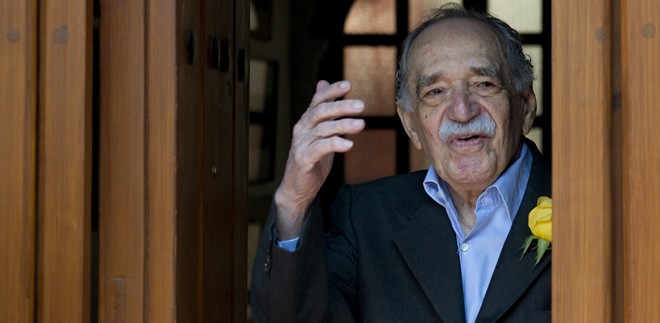

What could be common between Colombia and Pakistan, except cocaine or the history of military dictatorship? Not many in Pakistan are familiar with that far off country of Latin America. Yet for millions around the globe Colombia is recognised through the writings of its greatest author, Gabriel Garcia Marquez. His recent death was mourned all over the world, especially in Latin America and particularly in his own country which he left to live in Mexico but where he was regarded as a god.
I got to know about an admiration of this kind when I met a librarian from Bogota at a conference in Berlin. For me this god-like stature was not entirely unexpected. However, the unexpected came into the conversation when I informed the librarian that a substantial number of Marquez’s work is available in Urdu.
Garcia Marquez recognised this important role of translators and, on more than one occasion, expressed his admiration for Gregory Rebassa who translated most of his novels and short stories into English. According to Marquez, the translations are so good that "I think that my work has been completely re-created in English".
Thanks to Rabassa, we were all able to access Gabriel Garcia Marquez. As a third year student of visual arts, books were not the first choice to indulge in. Yet spotting One Hundred Years of Solitude on a friend’s bookshelf and intrigued by the title, I asked if I could borrow it. Reading the novel during those long days of summer vacations in my village, I realised the book was not about Macondo (the fictional town created by the author) or about Colombia or South America but about my village. I could identify so well with characters from the book.
Never has any other book, even those written in Urdu, had that kind of impact on me. The novel led to other works till I had read each word of this writer available in English. The introduction to magic-realism through Marquez was a way of exploring the common links between literature of that continent and our own reality. It was not only in the fiction of Marquez but the writings of Alejo Carpentier, Mario Vargas Llosa, Manuel Puig, Julio Cortazar, Carlos Fuentes, Jose Donoso and Augusto Roa Bastos that a different kind of reality was constructed -- distinct from the ‘realistic’ consequence of Western tradition of science, rationalism, Enlightenment.
Hence in this literature, the straightforward and logical sequences were put aside to incorporate events, incidents and characters from different periods and distant places present at the same time. In these literary works Time did not travel in a linear format, but moved in spirals, recurring and repeating itself. So the fiction was not a reflection of reality, but a reconstruction of it. If one analyses the novels and short stories of Marquez and his contemporaries (the practitioners of magic-realism) super-natural is concocted and communicated in a way that it becomes believable.
This blend of observation and imagination is managed, in the words of Marquez, by using a journalistic trick: "For example, if you say that there are elephants flying in the sky, people are not going to believe you. But if you say that there are four hundred and twenty-five elephants in the sky, people will probably believe you."
This brings the technique of magic-realism close to the aesthetics of Indian miniature painting. In a genre that developed in different dynasties and epochs one can easily identify distinct formal elements and conceptual constructs -- markedly different from European art. These miniatures were contrary to notions of observation in European painting in which the world was viewed as if seen through a window; hence illusion of space was managed through the invention of a two-point perspective. This scheme of observing and recording the outside world from a single perspective and in naturalistic details was popular in Western novel (a late invention in European literature) too, with emphasis on realistic stories narrated through a sole character, may that be the author or the main protagonist.
In comparison to European realistic painting, the art of miniature devised a distinct pictorial space -- including multiple perspectives within one picture frame. Thus the roof of a building was viewed from a direction different from its floor, or objects were drawn as if placed on eye level, while their base was depicted as if observed from top. In other works too, especially Hamzanama (from Akbar’s court), a harmony of flat rendering and spatial suggestion was achieved.
All these formal aspects defined that the painters and patron did not perceive a painted surface to be a replica or reproduction of reality but a substitute, with independent qualities and characteristics.
Along with these formal points, the Indian miniature absorbed the combination of real and fantasy, or dream and actuality. This mix of reality and imagined, that was evident in portraying mythological figures, genies and fairies, is at its utmost sophistication in the two miniatures by Bichitr painted during Jahangir’s reign, in which the Emperor is shown in contact with other rulers (Shah Abbas of Persia, and King James I of England) whom he had never met in person. These paintings also include symbolic objects and locations (the Emperor situated on a throne based upon hourglass, or two royalties embracing each other standing on the world semi circular with its map visible) while resting their feet on lion and sheep.
The infusion of fantasy and reality is not peculiar to Indian miniature. In many other cultures, the works of folk or high art have this merger, but what differentiates miniature from other such examples is the level of realistic rendering to produce works of imagination -- something that has a parallel in the writing of Gabriel Garcia Marquez with its fantastic details conveyed with great conviction, almost truth-like.